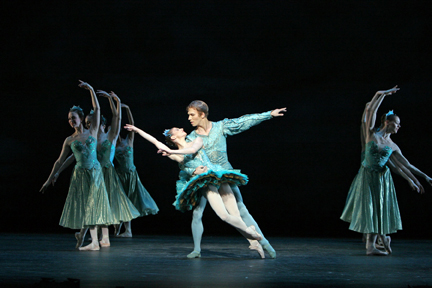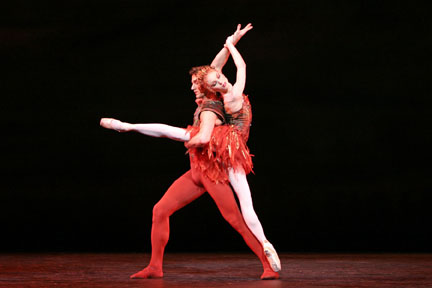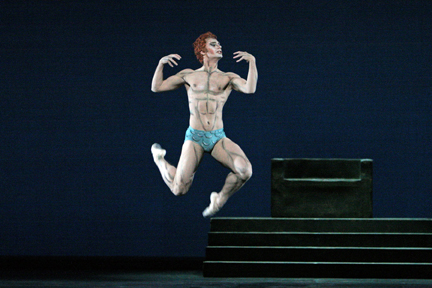Two Birthday Offerings
“Homage to the Queen”
The Royal Ballet
Royal Opera House, Covent Garden
London, UK
5-9 June, 2006
By John Percival
copyright ©2006, John Percival
 In spite of a season celebrating Frederick Ashton’s centenary, with great benefits to audiences and dancers, there are still quite a few of his ballets we haven’t seen lately, and among them until this past week was “Homage to the Queen”, his creation to mark Elizabeth’s coronation, premiered on the actual day, 2 June 1953. (Let me remind you that New York City Ballet gave a special programme at City Centre the same night: Ashton’s two NYCB creations, “Picnic at Tintagel” and “Illuminations”, plus the premiere of Jerome Robbins’s “Fanfare” to Benjamin Britten’s Variations on a Theme of Purcell — two British composers for the price of one.)
In spite of a season celebrating Frederick Ashton’s centenary, with great benefits to audiences and dancers, there are still quite a few of his ballets we haven’t seen lately, and among them until this past week was “Homage to the Queen”, his creation to mark Elizabeth’s coronation, premiered on the actual day, 2 June 1953. (Let me remind you that New York City Ballet gave a special programme at City Centre the same night: Ashton’s two NYCB creations, “Picnic at Tintagel” and “Illuminations”, plus the premiere of Jerome Robbins’s “Fanfare” to Benjamin Britten’s Variations on a Theme of Purcell — two British composers for the price of one.)
“Homage” seems to have been a rather late idea. The Royal Opera House, at the insistence of Lord Harewood, was concentrating its attention on Britten’s new opera “Gloriana”, and as late as March 1953 the magazine Dance & Dancers complained that no British ballet company was marking the occasion. A month later came a rumour that Ninette de Valois and Ashton might collaborate on a new work for the coronation, to be built around the four queens of England. Finally, as we know, Ashton did it alone, and the four queens depicted were the imaginary ones of Earth, Water, Fire and Air, played by the company’s four ballerinas. At its premiere, the show started late (at 8pm) so that after “Swan Lake” Act 2, starring Fonteyn and Robert Helpmann (returning as guest) and an intermission, the audience could be back in their seats to hear, by courtesy of the BBC, a speech by the Queen at 9 o’clock, followed by the new work. (The programme then ended with “Façade” although some spectators departed to watch fireworks instead.)
 And now we still don’t actually have Ashton’s “Homage”. His Air section, made for Fonteyn and Somes, could be revived as it had contained little more than their duets and solos, which were revived in 1970 for Ashton’s farewell gala. But the rest of the ballet was not given since 1958 and although Christopher Newton has devised an approximate version of the entry and coda, we are told nobody could remember the rest. Did they try hard enough? — there are quite a few of the original dancers around. However, instead Monica Mason asked three present-day British-born choreographers to contribute new versions of the missing sections, and it works better than might have been expected.
And now we still don’t actually have Ashton’s “Homage”. His Air section, made for Fonteyn and Somes, could be revived as it had contained little more than their duets and solos, which were revived in 1970 for Ashton’s farewell gala. But the rest of the ballet was not given since 1958 and although Christopher Newton has devised an approximate version of the entry and coda, we are told nobody could remember the rest. Did they try hard enough? — there are quite a few of the original dancers around. However, instead Monica Mason asked three present-day British-born choreographers to contribute new versions of the missing sections, and it works better than might have been expected.
I’m not convinced that many people would agree with the remark attributed to Dame Ninette in 1953 that the score specially written by Malcolm Arnold was the best ballet music since Tchaikovsky (did she really say that?), but although composed in a great hurry to meet a two or three week deadline it’s a lot better than some people are now suggesting. Eminently danceable, and theatrical too, it makes good use of wind and brass for its grand opening fanfare and polonaise, then sets a distinctive mood for each of the elements. The structure responded also to the casts Ashton had set, and Mason therefore asked the new producers to copy his distribution of numbers.
David Bintley, in his highly skilled and professional arrangement for Earth, made excellent use of Leanne Benjamin as the ballerina Queen, partnered by Federico Bonelli, who was also notable in a well arranged solo. They were escorted by a pas de six (three women and three men) and six further female attendants. A second cast of Jaimie Tapper and Martin Harvey was not in the same class. However, Alina Cojocaru with Johan Kobborg and their alternates Miyako Yoshida with Valeri Hristov all did well in Water, prettily arranged by Michael Corder, and Laura Morera did a good solo in the pas de trois, although Julia Farron and Brian Shaw used to be more eminent in this. In fact Ashton’s Water sequence as a whole was exceptional, and gave Violetta Elvin as the Queen by general consent her finest created role.
 Christopher Wheeldon in Fire seizes on the music of the brilliant solos Ashton made for Alexander Grant as the Spirit of Fire to create a spectacular role for Steven McRae (Sydney born, only in his second year with RB but already a first artist — what we used to call coryphée). He tackles it with tremendous zest and stops the show at each performance. But Wheeldon hasn’t made anything remotely as good for his principals, Sarah Lamb and Gary Avis; even the swifter, far stronger and more personable Marianela Nunez (insultingly presented as second cast, with Thiago Soares) couldn’t make this disappointing section interesting. And Darcey Bussell was, frankly, too much of a lump for the Fonteyn role in Air, with David Makhateli struggling to support her. It was when Tamara Rojo and Rupert Pennefather took over that the quality of Ashton’s choreography came across.
Christopher Wheeldon in Fire seizes on the music of the brilliant solos Ashton made for Alexander Grant as the Spirit of Fire to create a spectacular role for Steven McRae (Sydney born, only in his second year with RB but already a first artist — what we used to call coryphée). He tackles it with tremendous zest and stops the show at each performance. But Wheeldon hasn’t made anything remotely as good for his principals, Sarah Lamb and Gary Avis; even the swifter, far stronger and more personable Marianela Nunez (insultingly presented as second cast, with Thiago Soares) couldn’t make this disappointing section interesting. And Darcey Bussell was, frankly, too much of a lump for the Fonteyn role in Air, with David Makhateli struggling to support her. It was when Tamara Rojo and Rupert Pennefather took over that the quality of Ashton’s choreography came across.
I think we weren’t altogether happy with Oliver Messel’s designs for “Homage” in 1953, and I’m altogether not happy with Peter Farmer’s new ones now — too congested — but the large cast (48 altogether) presented themselves well. On the night of the premiere we also had a revival of de Valois’s ballet “The Rake’s Progress” — created 1935 but not seen lately in London. Its animated handling of a plot based on William Hogarth’s celebrated cartoon sequence by Gavin Gordon, who also wrote the music, seemed to please most spectators; personally I thought the staging, or the performance, concentrated far too much on steps and too little on character. Only Laura Morera and Belinda Hatley alternating as the betrayed girl, and Viacheslav Samodurov as second cast in the title role (much more suited than Johan Kobborg’s first-night fussiness) looked kind of OK — not great, but OK — and the brothel scene was especially ghastly. When you’ve got after-Hogarth designs by Rex Whistler, by the way, not to mention Messel’s proscenium arch blocking in the too-large stage, a little more light than John B. Read provides might not be a bad idea.
 Between these ballets came a flush of eight so-called divertissements — bits and pieces, one for every decade from the 1930s. These were highly variable in quality and in performance; highly incomplete, too, if meant to show the company’s development: no Cranko, no Helpmann, no Howard, no Tudor — although we got Wayne McGregor’s “Qualia” of all monstrosities. The best bits were Samodurov as de Valois’s Satan, Alexandra Ansanelli in an Ashton “Birthday Offering” titbit, Rojo and Soares in MacMillan’s “Farewell” pas de deux — all with less good casts some nights.
Between these ballets came a flush of eight so-called divertissements — bits and pieces, one for every decade from the 1930s. These were highly variable in quality and in performance; highly incomplete, too, if meant to show the company’s development: no Cranko, no Helpmann, no Howard, no Tudor — although we got Wayne McGregor’s “Qualia” of all monstrosities. The best bits were Samodurov as de Valois’s Satan, Alexandra Ansanelli in an Ashton “Birthday Offering” titbit, Rojo and Soares in MacMillan’s “Farewell” pas de deux — all with less good casts some nights.
“Homage” had only five showings, and no more announced. One night (8 June) the Queen and the Duke of Edinburgh came, as part of her 80th birthday celebrations and the Royal Ballet’s 75th anniversary. Ashton’s “La Valse” replaced “Rake” that night, presumably to give the corps a break, and the diverts changed. On the good side were Sylvie Guillem’s Maliphant solo “Two” (might that be her RB farewell?) and Birmingham Royal Ballet dancers presenting duets from “Two Pigeons” (Nao Sakuma, Chi Cao) and “Lady and the Fool” (Elisha Willis, Robert Parker), also the reel from “La Sylphide”. On the less good — no, let’s be kind. The management sat their royal visitors in the so-called royal box, which gives a lousy view right round the side; did having the whole company sing “Happy birthday” at the end make up for this?
Photos:
Royal Ballet HOMAGE TO THE QUEEN. Top centre DARCEY BUSSELL, next underneath L to R SARAH LAMB, ALINA COJOCARU, LEANNE BENJAMIN; photograph: ©Dee Conway.
Royal Ballet HOMAGE TO THE QUEEN. ALINA COJOCARU, JOHAN KOBBORG as Queen of the Waters and Her Consort; photograph: ©Dee Conway
Royal Ballet HOMAGE TO THE QUEEN. SARAH LAMB, GARY AVIS as The Queen of Fire and Her Consort; photograph: ©Dee Conway
Royal Ballet DIVERTISSEMENTS - JOB - SATAN'S SOLO; VIACHESLAV SAMODUROV; photograph: ©Dee Conway
Volume 4, No. 23
June 12, 2006
copyright ©2006 John Percival
www.danceviewtimes.com